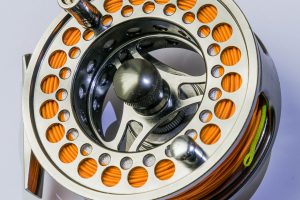Catfish generally have good eyesight, which helps them hunt for prey and navigate for food. However, their eyesight depends on the time of day, the water conditions, specialized habitat, age, perception of threat, and many other factors. Depending on these factors, the power and utility of their eyesight change. This article will explore the details of a catfish’s eyesight.


How good is a catfish’s eyesight?
Catfish are unique among fish when it comes to their eyesight. Their highly developed vision sets them apart from many other animals. Catfish are primarily nocturnal, and their eyes have adapted to low-light conditions. Their eyes contain more rod cells that act as photoreceptors responsible for detecting light in dim environments. This adaptation allows them to see well in murky or dark waters, while other fish might become blind.
Additionally, catfish have specialized eyes that can detect various colors. This is rare in many fish species. This ability to perceive colors is beneficial for hunting and identifying prey. Catfish primarily rely on their keen sense of smell and taste to locate food. Still, their good eyesight aids in locating and capturing prey in dim light conditions.
Catfish have a unique combination of good low-light vision and color perception compared to other fish species. This makes them well-suited for their nocturnal and often muddy or dark aquatic habitats. This adaptation allows them to navigate and hunt more effectively than other fishes.
Why are catfish eyes unique?
Catfish possess a fascinating and unique visual system that sets them apart from many other fish species. The anatomy of catfish eyes plays a pivotal role in their exceptional eyesight and vision.
Size of the eyes
Catfish have relatively large eyes that provide a wide field of vision. This size lets them capture more available light, making them well-suited for dimly lit environments.
Tapetum Lucidum
Behind the retina, catfish have a specialized structure named the Tapetum Lucidum. This layer can reflect incoming light back through the retina. As a result, photoreceptor cells get a second chance to detect light. This enhances their sensitivity to low-light conditions and gives them superior night vision.
Rod cells
Catfish have more rod cells in their retinas than most species. Rod cells are susceptible to light and receive much of it. The increased number of rod cells in catfish retinas enhances their ability to see in dim or murky waters. This is a crucial feat for their nocturnal lifestyle.
Cones for color vision
Unlike many other nocturnal animals, catfish also possess a higher number of cone cells. These cells are typically associated with color vision. These cells let them perceive a broader spectrum of colors, even in dark environments. The presence of cones contributes to their ability to identify prey and distinguish objects more precisely.
Pigment cells
Catfish tend to have darkly pigmented eyes. This can help reduce the impact of excess light and enhance their low-light vision.

How do catfish adapt their vision to low-light environments?
One of the biggest reasons catfish are highly efficient nocturnal hunters is that they are remarkably adaptable to low-light environments. Their eyesight is a crucial element of this adaptability. Their unique vision abilities result from specific anatomical adaptations that enable them to thrive in conditions where other fish may struggle. The factors are briefly described below:
Nocturnal behavior
Catfish are primarily nocturnal and are most active during the night. Through evolution, their eyes have adjusted to darkness. So, this behavior lets them take advantage of lower light levels when hunting and avoiding predators.
Enhanced sensitivity
As mentioned earlier, catfish have more rod cells in their retinas. As they are susceptible to light, even low-light conditions stimulate them. This heightened photosensitivity allows catfish to see in murky or dark waters.
Tapetum Lucidum
The tapetum lucidum is a reflective layer behind the retina. This structure reflects incoming light, amplifying the available light for the photoreceptor cells. This dramatically improves the vision in low-light environments.
Color vision
Unlike most other nocturnal animals, catfish possess many cone cells, allowing colored vision. Seeing a broader spectrum of colors aids in seeing in dim light.
Catfish are one of the few species notably adapted to low-light conditions. Some other fish with similar abilities include particular nocturnal and deep-sea creatures, like some species of anglerfish and lanternfish. These fish have also developed specialized adaptations to make the most of the limited light available this deep in the ocean. But catfish, despite not being deep-sea creatures, have the same vision abilities as them.
Do catfish see color?
Catfish can see colors, setting them apart from other nocturnal animals. Their ability to see color is an interesting evolutionary adaptation that enhanced their overall vision.
The reason why catfish see color is because they have specialized cone cells in their retinas. Cone cells are photoreceptor cells. These cells allow animals, including us, to perceive different wavelengths of light, which our brains interpret as colors. So, these cone cells are mainly responsible for colored vision in catfish and humans.
The presence of cone cells in catfish is a rather unusual occurrence among nocturnal animals. Most nocturnal creatures predominantly have rod cells in their retinas. While highly sensitive to low light levels, these cells do not provide color vision.
On the other hand, catfish have evolved to have many cone cells. As a result, they can distinguish a broader range of colors, even in low-light conditions. This ability is particularly advantageous for catfish, who are predatory and opportunistic feeders. It allows them to identify prey and distinguish objects more precisely in their often murky, dimly lit aquatic environments.
How do catfish detect prey and predators?
Catfish are skilled predators. They have an exciting prey detection mechanism. Catfish actually employ a multi-sensory approach to detect prey and predators.
Catfish employ a combination of sensory mechanisms to detect both prey and predators in their aquatic environments. In this case, their eyesight plays a crucial role. But they rely on other senses as well.
Eyesight
Catfish have adapted their vision to low-light conditions, so their eyesight is beneficial for detecting motion and identifying potential prey. Their large eyes with many rod cells are well-suited for nighttime hunting. They can easily spot the movements and silhouettes of smaller fish, insects, or crustaceans.
Olfaction (smell and taste)
Catfish have an exceptional sense of smell. They have chemoreceptive barbels, basically whisker-like appendages near their mouths. These barbels are filled with sensory cells. Using them, they can detect chemical cues, such as the scent of potential prey or the presence of predators. Catfish can also follow scent trails left behind to locate food or sense danger. Moreover, they use their barbels to taste their surroundings, which helps them determine the edibility of potential prey.
Lateral line system
Catfish possess a lateral line system with sensory organs along their sides. This system enables them to detect changes in water pressure and sense movement in the surrounding water. Using this, they can sense vibrations caused by the movement of nearby fish or prey or potential threats. This is particularly useful for hunting in the dark, where visibility is limited.
Electroreception
Some catfish species, like the electric catfish, possess electroreceptors. These receptors can detect weak electric fields produced by other organisms. This ability aids them in locating prey, mainly when prey fish emit electric signals. It also helps in navigating their surroundings.
How does catfish vision vary among different species?
Catfish vision varies among different species, as there are variations in their habitat, lifestyle, and evolutionary adaptations. Here are some examples of how catfish vision differs across species:
Nocturnal vs. Diurnal Species
Nocturnal species of catfish, like the channel catfish (Ictalurus punctatus), have evolved to have highly developed low-light vision. Their eyes contain more rod cells and a reflective tapetum lucidum, which enhances their night vision.
Diurnal catfish, such as the South American Pimelodus (Pimelodus blochii), are more active during daylight hours. So, their eyes are adapted to brighter conditions. They might have fewer rod cells but still retain good color vision.
Habitat specialization
Some catfish species inhabit clear, well-lit waters. For example, the Corydoras catfish is found in South America. These species rely more on color vision to identify prey and navigate their aquatic environment.
On the other hand, catfish that primarily live in muddy or turbid waters, such as the flathead catfish (Pylodictis olivaris), often prioritize their low-light vision for hunting due to limited visibility. Their eyes may have more rod cells than their clearwater cousins.
Electroreceptive Species
Catfish, particularly the electric catfish (Malapterurus electricus), have specialized in electroreception. This is an attractive evolutionary trait that has made many scientists interested. These catfish use electrical signals to locate prey and navigate, often relying less on traditional vision. So, despite having a somewhat developed vision, it acts more as a secondary accessory. They have evolved distinct strategies to thrive in their environments.
Deep-Sea Catfish
Like the abyssal catfish (Abyssobrotula galatheae), deep-sea catfish species inhabit the darkest of ocean depths. Having lived in this kind of environment for generation after generation, these species have developed unique adaptations for extreme low-light conditions. Usually, their eyes contain fewer cone cells and even more sensitive rod cells, helping them survive and navigate the darkness.
What factors affect a catfish’s eyesight?
Several factors can affect a catfish’s eyesight. This will, in turn, influence how well they perceive their environment, prey, and potential threats. Here are the key factors that impact a catfish’s vision:
Light levels
The most significant factor affecting a catfish’s eyesight is the amount of light. Catfish are adapted to low-light conditions, and their vision is optimized for dim environments. Which is to say, bright light can temporarily blind them. It can make them less effective hunters or more vulnerable to predators.
Water clarity
The clarity of the water catfish inhabits is crucial for their eyes. In clear water, catfish can rely on their perfect vision to spot prey and predators more effectively. In turbid or muddy water, their vision becomes limited. Then, they must rely more on their other senses, like smell and the lateral line system.
Habitat
Different catfish species are adapted to various aquatic habitats. Some species prefer well-lit, clear waters, while others work better in dark, murky environments. Habitat specialization naturally affects the catfish’s vision. This results in some species evolving to have better color perception while others prioritize low-light vision.
Time of day
Catfish are usually nocturnal, so their vision is most acute at night. During the daytime, their eyesight could be more effective. So, they may rely more on their other senses to navigate and locate food.
Aging
Just like in humans, the eyesight of catfish deteriorates with old age. Older catfish may have a different visual acuity than younger individuals, which makes hunting and avoiding predators more challenging.
Genetics and Species Variability
Different species of catfish have evolved different eye structures and retinal adaptations. The number of rod and cone cells, the presence of a tapetum lucidum, and other genetic factors can vary among different species of catfish. These genetic factors also end up impacting their vision capabilities.
Predator-prey dynamics
Potential predators in the peripheral environment can affect a catfish’s vigilance and its use of vision while they detect threats. Catfish may adjust their behavior and visual reliance depending on whether they perceive themselves as at risk. In other words, they will adapt their use of vision based on whether they’re relaxed or endangered.
As you can see, catfish have something exciting going on regarding their vision. Have you had fun learning about the unique catfish eyesight?











